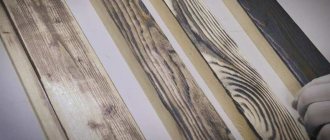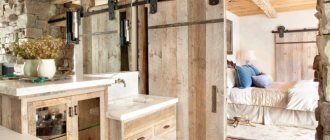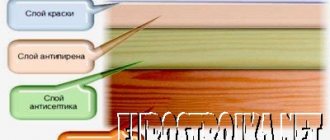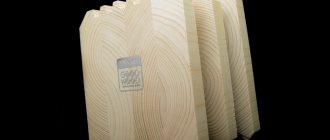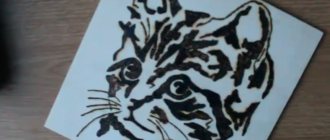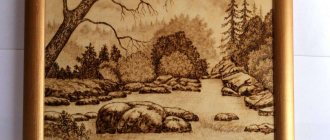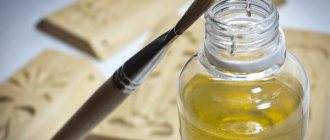Using wood in interior design has always been a great opportunity to emphasize a unique style, add coziness to a room, or give a special mood. Brushing wood copes with all these tasks at once; in addition, artificial aging gives objects and surfaces a special character, adds solidity, and hints at a rich history. You can master such a technique yourself, just familiarize yourself with the technology and select the necessary materials and tools.
Wood aging methods
Artificial aging of wood is actively used by designers in creating unique interior projects. This popularity is explained simply: the wood retains all its physical characteristics, while acquiring a new, spectacular and original look.
There are three methods for aging wood:
- Mechanical – a wooden surface is either treated with a metal brush, as a result of which the soft top layer is removed and the texture becomes embossed (brushing); or tinting compounds are applied followed by sanding the board (patination). Often both methods are combined to obtain a more expressive texture and color of wood.
- Chemical - a special composition based on alkali or ammonia is applied to the surface, changing the color of the upper layers of hardwood.
- Thermal – lightly burning wood of any type with a torch, followed by sanding with a wire brush and tinting.
Hard wood species are suitable for brushing - oak, walnut, almost all conifers. Patination is used mainly on wood with a weak texture - beech, cherry, maple.
Despite its complexity, wood brushing technology today is one of the most popular among all types of decorative processing. It is used in the manufacture of antique-style furniture, parquet, wall and ceiling panels, doors, stairs, and flooring. Such decorative finishing is appropriate in the interior of apartments, cafes, shops, galleries, and studios. Aged wood adds expressiveness to any setting and hints at the “historicity” of the place.
Types of brushes
During such work, three stages are distinguished - rough finishing, intermediate stage and sanding the wood.
To carry out the procedures correctly, you need to have different types of brushes in terms of hardness, this applies to any type of instrument.
Also, products for this procedure have differences in size, which affects their cost. Certain types are suitable not only for certain aging devices, but also for others (grinders) because they have an adapter.
Made of metal
Used for basic wood finishing.
The best types of brushes have brass steel hairs. Cheaper options simply have steel bristles. For hard wood, you can use any type of tool; for soft wood, it is better to buy the first type of brush.
In addition, you can find copper options made of metal, but they are not suitable for basic processing, and it is better to use them for polishing and finishing procedures.
Artificial
The intermediate stage involves the use of a nylon tool. After basic finishing, the base becomes rough, and nylon smoothes out all defects. There are many different brushes on sale, which differ in shape, size, and some can be combined with an angle grinder.
The nylon version has differences in the following indicators: length of bristles, level of density, number.
Certain options have a specific pile into which abrasive particles are pressed.
The grain size varies: the better the quality of the procedure, the larger the size of the grains you need to choose.
The level of rigidity of nylon pile will be determined by numbers (120 - 600). For hard wood you need to buy an indicator of up to 240, for soft wood - up to 600.
Nylon bristles are attached to a plastic or metal base. Even taking into account the good strength of metal, plastic still lasts longer.
The pile hardly breaks, is always flexible, and therefore shows excellent performance.
Features and benefits of brushing
Brushing (from the English brush) is essentially nothing more than structuring wood through additional rough processing. The latter consists of removing soft fibers from the surface of the material; the annual rings acquire additional texture. The technique got its name due to the fact that brushes are used to give the desired structure to the wood.
A similar aging effect is observed in wood sandblasting technology, when soft fibers are removed by a powerful sand stream. Unlike brushed wood, sandblasted wood is smoother.
Types of brushing directly affect which brushes are used:
- Deep – brushes with thick metal bristles are used.
- Light - created using brushes with synthetic hard bristles.
Brushing wood can be done with your own hands; most often this method is used for small amounts of work, since it is quite labor-intensive and time-consuming. Brushing of massive elements (parquet, stairs, large boards) is most often done in a factory, where special machines with replaceable brushes are used, and the process is as automated as possible.
There are several brushing methods, but the most popular are the following:
- Manual - brushes and abrasives are used. Manual processing is of great decorative value, but is more labor-intensive and is suitable for small elements.
- Electromechanical - an angle grinder or brushing machine is used for the appropriate materials, as well as suitable attachments for a drill or grinder.
Natural aging of wood is a long process. Under the influence of external factors (ultraviolet radiation, temperature changes, precipitation, wind), the tree trunk wears out. The surface literally crumbles, leaving only the hardest fibers in place. There is a decorative effect, but during natural processes the material loses its basic properties: it becomes less durable, susceptible to destruction and rotting.
The advantages of brushing wood include:
- Improving the original properties of wood. The material becomes stronger, less friable, and resistant to external factors, mold, and fungi.
- High decorative qualities based on noticeable contrast and brightness of the texture after removing the soft layer of fibers. Such materials and decorative elements are universal, fit into almost any interior, making it more solid and exclusive.
- Large selection of wood for subsequent processing.
- Wood tinting can be done in several colors at once. For example, the base is painted in a light shade, and the pores in a contrasting dark or bright shade.
The only disadvantage of brushed wood is the difficulty of processing; the process will take a lot of effort and time.
By the way! After brushing, the wooden surface can be varnished, stained, waxed, oiled or tinted using impregnations. Decorative coating is necessary to emphasize the texture of the product; without this, the wood will not look expressive enough.
There are many possibilities for using brushed wood, especially since the finished product can be given almost any look, based on the general style of the interior. It can be a monotonous or combined color, the effect of a dusty or moldy surface, imitation of chips, cracks, gold or silver embossing.
Is an angle grinder suitable for working with wood?
The only operations with wood that can be performed with an angle grinder (angle grinder) without danger are grinding and roughing, and then using special attachments. Of course, you can cut wood, but it is strictly prohibited! The Internet is full of shocking photos showing what can happen when using an angle grinder as a cutting tool for wood.
The main arguments that can be made against using an angle grinder for sawing are as follows.
- This machine is not designed for sawing wood.
- Since wood has a viscous and soft structure, the saw blade can jam in it. As a result, the grinder is often torn out of the hands, and it flies in an unpredictable direction (in the leg, along the arms, in the stomach, etc.), causing deep wounds or amputation of fingers. Even fatal cases have been reported.
- When cutting wood, the saw blade heats up very quickly, causing it to begin to lose strength. The slightest misalignment or excessive pressure may cause it to fly apart. Since the spindle speed of an angle grinder is high, tool fragments fly away at the speed of shrapnel and penetrate deeply under a person’s skin. The user will be lucky if the fragments do not fly into the head or eyes.
- Despite the dangers of using saw blades with teeth, some angle grinder users ignore this fact and continue to install compass disks with large teeth or improved with carbide tips. If, when cutting wood, a hard knot or nail residue gets caught in it, the tooth or solder breaks off, gets caught by the next saw tooth and is thrown out at the speed of a bullet. One can only guess about the consequences.
- Ignoring all the warnings, users of grinders install a circular saw on the machine with a larger diameter than the protective casing. This is the most dangerous option for using an angle grinder.
If you have to cut wood constantly, it is better to purchase a special machine for this purpose, or use a jigsaw. In extreme cases, the grinder can be used as a drive and made into a circular saw, securing the device rigidly to the frame.
Choosing wood for brushing
Not every tree can be processed using the brushing method. This is due, first of all, to the structure of the fibers. Soft or medium-hard rocks that have a well-defined annual ring structure are best suited. These types of wood include:
- Coniferous species.
- Larch.
- Oak.
- Nut.
- Ash.
- Merbau.
- Wenge.
After processing, the relief of such wood is clearly visible, the pattern is contrasting and expressive. The surface turns out to be quite rough, with a clear structure of grooves.
The harder the rock, the less pronounced the relief will be on the finished surface.
Some types of wood cannot be processed by brushing, these include:
- Teak.
- Maple.
- Cherry.
- Linden.
- Pear.
- Beech.
In these tree species, the fibers are insufficiently pronounced or there is no division of annual rings (in some tropical species).
Light brushing can be used on plywood or lining to make the surface more expressive.
Staining or tinting brushed wood
Coating the surface of brushed wood with paint or a tinting composition gives it a special decorative effect. Painting is carried out with a brush or sponge. During the process, carefully monitor whether the fibers rise. If fibers are noticed on the surface, it is additionally sanded with fine-grained sandpaper.
The simplest painting option is stain treatment. It quickly penetrates into the soft layers of wood remaining on the surface without affecting the hard fibers. The result is a relief structure that is particularly decorative.
Wood coated with a golden or silver coloring substance has an original appearance. Pigment particles get clogged into depressions and microcracks, which subsequently glare in the sun.
An interesting coloring technique is the arrangement of tones, repeating the play of light and shadow on the relief. The recesses are painted in a dark tone, the ridges in a light tone. Painting is carried out as follows:
- A richly dark varnish or paint is applied to the entire surface.
- The coated surface is wiped with a sponge or rag, removing paint from hard fibers where it has not yet been absorbed.
- If large areas are being painted, wait until the applied layer of varnish has dried, and then treat the surface with a petal disk with a grain size of 400 to 800. The bulges after this treatment are highlighted, then they are coated with colorless or light varnish.
Another coloring option is to cover the top tier with dark varnish and the depressions with light varnish. In this case, apply dark varnish to the surface and dry it well. Then apply the light composition and remove its excess with a rubber spatula. As a result, a dark substrate appears on the ridges.
With certain woodworking skills and using the right tools, you can do your own brushing and get excellent results. Products made from structured wood are highly decorative and give the interior an exclusive, expensive look.
Brushing equipment
To brush wood with your own hands, you will need a prepared workplace and a minimum of equipment:
- Brushes with metal bristles of different thicknesses and hardness - for rough woodworking, easily remove soft fibers.
- Sandpaper – coarse grit for rough sanding and fine grit for fine polishing.
- Decorative compositions – stain, wax, oil, tinting impregnation.
- Varnish – for finishing coat and fixing the tinted layer.
Using this set you can process small volumes of material, for example, in the manufacture of furniture and small decorative elements.
Structuring large volumes of wood (floorboards, panels, door panels) is best done using appropriate tools. Professionals use grinding machines (manual or machine) or special devices for brushing. Special attachments for drills and grinders are also suitable. A tool for brushing wood greatly simplifies the process, saves time and effort, but requires experience in use.
Brushes
Brushing brushes are used to brush wood. The pile is usually steel or brass, rough. The type of such brushes is disk, and it is best if they are shaped like a roller with a wide end part. In this case, surface treatment will be as uniform and comfortable as possible.
The thickness of the wire should be selected based on the type of wood being processed. The pile should be approximately 7-10 times thinner than the soft veins. When choosing between curled or straight bristles, it is better to choose the second option. The same rules apply to sander attachments.
Important! Too hard or wide bristles on a metal brush will damage the texture of the wood and the product will turn out unsightly.
Using metal brushes, the surface is roughly processed, after which it becomes quite rough. A nylon brush will help improve the result. These synthetic brushes have abrasive powder applied to the plastic bristles, which helps smooth out the hairiness of the surface, making it smoother and cleaner.
To obtain the ideal quality of wood processing, polishing is added at the final stage. To do this, use brushes with natural bristles, but quite hard (coarse wool, sisal).
Machine tools and power tools
Electric tools provide good processing quality and also significantly save time. When choosing between a grinder and a drill, it is better to prefer the second option. With a drill, it is easier to control the speed and direction of processing wood.
To brush wood with a grinder, drill or angle grinder, you will need attachments corresponding to the same types of brushes as for manual processing. In addition, care should be taken to securely fix the workpieces with clamps, as well as personal protective equipment (safety glasses, gloves, vacuum cleaner), since processing with power tools generates a large amount of dust.
Tools
0 votes
+
Vote for!
—
Vote against!
City dwellers, who have lived their whole lives in the metal dungeons of the concrete jungle, are gradually losing interest in faceless urban interiors, preferring classic, vintage and rustic styles, characterized by emphasized individuality. An integral component of these interiors is wood - a popular finishing material, thanks to which they acquire uniqueness and original beauty. However, there are some tricks here too - if country and eco-styles are often complemented by wood in its pristine natural form, then within the framework of vintage and even classic styles, aged wood, which has a more attractive and noble appearance, will be more appropriate. Almost any interior element can be made from it: it can be a vintage lamp, a wooden chest of drawers exuding comfort, or the classic use of wood in the interior - making window sills and doors. Under natural conditions, the aging process of wood takes more than one year; intricate patterns on its surface form slowly and unevenly, which makes aged wood a rare and expensive material. However, technology does not stand still, and over time, a method of artificial aging of wood, called brushing, was developed. Interest in this method of processing wooden surfaces is shown not only by lovers of luxury vintage furniture, but also by owners of suburban areas who have decided to diversify the interior decoration of their country houses. Considering the relevance of the problem, in this article we will look at the essence of the process of brushing wood, the main types and tools necessary for it, and also tell you how to brush wood with your own hands.
Content
- Aging of wood: basic information
- What is wood brushing: the essence of the method
- Advantages of artificially aged wood
- Wood Brushing Tools
- Tools for manual wood brushing
- Process automation: machines and brushing machines
- Brushing Wood: A Step-by-Step Guide
- Chemical brushing of wood
Aging of wood: basic information
If you carefully examine the appearance of the wood when cut, you can see a peculiar pattern - annual rings, in which dark and light tones alternate. This pattern is based on the alternation of hard (dense) and light (loose) fibers, the latter being more susceptible to time and aggressive climatic factors, which leads to their gradual wear. This is how the formation of annual rings occurs, which over time not only acquire density and contrasting shades, but also visible volume. This is the basis of the natural aging of wood - a process that takes many decades. Thanks to the lightning-fast development of innovative technologies, a unique opportunity has now emerged to artificially speed up the aging process of wood. This can be put into practice using the brushing method, which gets its name from the English word brush. In Russian there is a similar term, which is referred to as “wood structuring”.
What is wood brushing: the essence of the method
Brushing is a method of artificially aging wood, which involves the use of specialized tools and techniques. The brushing technique is based on the mechanical processing of wood with special metal brushes, with the help of which the softest upper fibers of the material are removed. Thanks to this technique, the hard surface of the wood is exposed, on which the texture of the material and the structure of the growth rings are clearly visible, and a beautiful relief is formed, emphasizing the aesthetic appearance of the finishing material. However, the brushing process does not end there. To emphasize the relief and make the structure of the wood even more distinct, it is highlighted with a color that gives richness to natural shades. To do this, the surface treated with a metal brush is unevenly painted, while the depressions formed as a result of the removal of soft fibers are painted in darker shades, and the surface texture is painted in lighter shades. Thanks to this technique, the wood relief becomes as noticeable as possible.
Important! In order for artificially aged wood to acquire maximum resemblance to a material that has aged in a natural environment, experts recommend painting the previously brushed material gray. Without waiting for the paint to dry completely, it is smeared from the relief surface. Thanks to this technique, it will seem that products made from artificially aged lumber have stood in the open air for at least 10 years.
Important! If natural aging negatively affects the performance characteristics of wood, weakening its structure, then thanks to artificial aging, carried out by brushing, the material acquires additional strength.
The artificial structuring method can be used in the processing of both hard and soft wood. The main requirement that wood to be brushed must meet is the presence of a clearly defined texture and clearly visible layers of varying hardness. Such materials include oak, pine, walnut, larch, wenge and ash.
As for alder, cherry, birch, teak, maple and beech, the brushing method will be proven to be ineffective for these species, since the distinctive feature of these trees is a fine-fiber structure without pronounced layering.
Advantages of artificially aged wood
- Wood that has undergone artificial structuring acquires an original appearance that meets the latest fashion trends;
- Brushed wood becomes resistant to rotting and various insects;
- By brushing wood with your own hands (the video presented in the article will simplify this process), you can independently make a lot of exclusive things that will not only last a long time, but will also emphasize the exclusivity of any interior;
- By performing decorative finishing on common and fairly cheap lumber, you can create an artificial imitation of exotic types of wood, the cost of which significantly exceeds the original price of the raw materials.
Wood Brushing Tools
At first glance, the process of artificially structuring wood may seem complicated, but even an inexperienced craftsman can do it if he has a certain set of tools at his disposal that will save time and effort spent on work. In addition, it should be noted that brushing wood can be done either manually or mechanized, which is largely determined by the tool used. Depending on the method by which wood brushing is carried out, the tool can be of the following types:
Tools for manual wood brushing
- Hand-held metal brushes , characterized by varying thickness and stiffness of bristles, are used for primary wood processing. The stiffness of the bristles is determined by the length of the wire; the longer it is, the softer the bristles. When choosing a brush for brushing wood, try to give preference to tools with the stiffest metal bristles. If necessary, it can be trimmed using a grinder, which will make the pile even tougher. When using a brush to brush wood, it is necessary to move its bristles along the grain in exactly one direction. Thanks to this technique, you can remove soft fibers from the surface of the wood, leaving hard fibers intact;
- A hand chisel is a tool with which you can make deep longitudinal grooves of various curvatures in wood fiber. When used skillfully with a chisel, you can achieve maximum realism in artificially structured wood by causing sufficiently deep cracks that create the effect of cracking the material;
- Coarse-grained sandpaper The technique of using sandpaper is similar to the technique of using a hand brush - it is also moved with pressure along the fibers, as a result of which grooves are formed on the surface of the wood, the structure of which is similar to the structure of natural fibers. By correctly selecting the abrasive grain size and using sandpaper with different grain sizes, you can achieve different depths and degrees of severity of the grooves;
- A grinder equipped with special brush attachments for brushing wood is another tool that is used for brushing wood. At the same time, at the initial stage, nozzles with metal bristles are used for rough surface treatment, and for the final stage, nozzles with copper and sisal bristles are used. Currently, a special nozzle for brushing wood “Piranha”, which is an abrasive-polymer brush, is in wide demand. Using this device, you have the opportunity to selectively remove fibers, focusing only on soft fibers and not affecting hard fibers.
Important! When working with an abrasive-polymer brush, you must ensure that the surface of the wood being treated does not burn when working at high speeds. To avoid this, you need to purchase a speed controller.
Important! After performing the initial surface treatment, experts recommend using a kerosene burner, with which the material is fired. Remember that a gas burner is not used for these purposes. Burning the wood surface with a kerosene burner promotes:
- removal of small wood fibers;
- drying the top layer of wood;
- highlighting and emphasizing the natural structure of wood.
Process automation: machines and brushing machines
On a production scale, the amount of work is many times higher, and therefore there is a need to automate the process, which involves the use of special machines. This helps simplify the work of producing aged wood, and also reduces time costs, allowing large volumes of work to be completed in a short period of time.
If you want to purchase special machines for brushing wood at home, it only makes sense if you plan to do a large amount of work. Let's look at the most common models of specialized equipment for brushing wood.
- Cleaning router or so-called brushing machine for brushing wood FESTOOL RUSTOFIX RAS 180. Three brushes are supplied with this device:
1. The first steel wire brush, which is used for primary wood processing;
2. A second synthetic bristle brush, intended for intermediate sanding;
3. The third - made of sisal is used for polishing the treated surface.
The Makita 974 sander can also be used for sanding wood, however, while working with it, difficulties may arise associated with processing corner areas. In this regard, at the joints between walls and floors, it is necessary to additionally use an angle grinder equipped with attachments;
- The Felisatti AGF 110/1010E grinder can be used to process both relatively smooth and uneven surfaces. Metal and nylon brushes are supplied with this device. It has an analogue - the Interskol sanding machine, which will make sanding wood much easier if you follow the instructions presented in our article.
Brushing Wood: A Step-by-Step Guide
If you are not a guru in the field of wood brushing, the master class and advice from our experts will help you study this wood processing technique in more detail.
Let's take a closer look at the wood brushing process.
- Before you begin the initial processing of the material, lightly moisten the selected workpiece, which will prevent the formation of wood dust during the work process. Prepare a working tool – a hand brush. To carry out the work effectively, make sure that the tool meets the minimum requirements - the brush must efficiently remove soft surface fibers without disturbing the structure of hard fibers. Having selected the hardness of a hand brush for brushing wood experimentally, use it to rough the material. During operation, the hand brush should be moved along the direction of the grain.
Important! If you decide to automate the process and carry out brushing using a grinder or grinder equipped with special brushes, remember that the movements of the tool attached to the grinding stone are also made along the fibers, and the selection of the rotation speed must be done in advance on a small sample of the material, since for different types of wood this technical parameter may vary significantly.
- After you have completed the initial hard processing of the wood, replace the working tool with a polymer attachment with an abrasive coating, using which you can grind the material, removing any remaining soft fibers from its surface. Once you have gotten rid of unnecessary roughness, evaluate the volume and quality of the work done, making sure that the quality of structuring meets your expectations. If you are not satisfied with the result, experts advise making the structuring more distinct by deepening the previously made grooves on the surface of the wood. At this stage, you can think for the first time about the decorative design of the surface of the material and, using a chisel, add additional indentations and grooves, giving them the appearance of cracks that appeared naturally.
- The next stage is the final polishing, for which you will need a sisal brush. If you plan to do it by hand, prepare sandpaper with a fine-grained abrasive surface, with which you will get a perfectly smooth surface of the workpiece. After this, the resulting workpiece must be dried and cleaned of dust, thereby preparing it for subsequent painting and varnishing.
- To decorate brushed wood, experts recommend using golden or silver paint, during the application of which particles of the coloring pigment will clog into the microcracks of the wood, causing reflections to appear on its surface in sunny weather. If you want to give the material a unique luxury and presentable appearance, patina it (painting the deepest cracks with darker paint).
Important! You can use stain as a coloring composition. To do this, apply it liberally to the surface of the material and quickly remove the excess. Thanks to this technique, soft fibers will absorb the paint, acquiring a darker shade, while hard fibers will remain light.
- After painting the wood, polish it again, which will smooth out all the unevenness that appeared after painting.
- After thoroughly washing, cleaning and drying the workpiece, you can coat it with varnish. To do this, you should use a specially designed parquet varnish, thanks to which the material will retain its original appearance and performance characteristics for a long time.
Chemical brushing of wood
Unlike mechanical brushing, wood brushing using chemicals is considered the most rare type of artificial structuring. Despite the fact that the use of chemically active compounds facilitates the brushing process, their widespread use is limited by the need for special knowledge and skills of the master working with chemicals. In addition, difficulties may arise in purchasing chemicals.
For chemical brushing of wood, acids (sulfuric and hydrochloric), alkalis and other caustic chemicals (ammonia) are used. After they are applied to the surface of the material, they corrode the soft fibers, and all that remains is to scrape off the unnecessary wood.
The sequence of work for chemical brushing is as follows:
- The surface of the material is polished and dirt is removed;
- A thin layer of the chemical used for brushing is applied to the surface to be treated;
- During the work process, it is important to monitor the evaporation of the chemical and, if necessary, reapply;
- After the chemical softens the outer fibers, the workpiece is washed under running water and the remaining chemical is removed using a soft brush;
- Then the wood is thoroughly dried, after which they begin to paint and apply varnish.
Wooden products made from brushed wood will become an original addition to classic and vintage interiors, fitting perfectly into the main stylistic concept. Aged wood in the form of wall panels, massive ceiling beams and columns will make any, even the most laconic interior, refined and aristocratic.
Brushing wood video
Stages of brushing technology - step-by-step instructions
The DIY wood brushing technique consists of the following steps:
- The prepared surface (cleaned and dry) is treated with a coarse brush, removing soft fibers to the desired depth. In this case, you need to move without strong pressure along the fibers and along the entire plane, so as not to disturb the structure of the wood. When using a power tool, you should set the number of revolutions to 1500-2200.
- Sanding with a synthetic brush (attachment). Movement also along the fibers until all roughness is eliminated. Periodically you need to tap the workpiece on the back sides to remove dust.
- Polish with a softer brush; even the abrasive side of a regular dishwashing sponge will do. At this stage, the product is given smoothness and a slight glossy shine.
If you point the tool across the fibers during processing, you can get unusual patterns in the form of scratches, but you should not abuse this. It is better to use a similar technique on separate inserts to give the product an additional decorative effect.
Cup and other types and shapes
Various shapes of nylon brushes allow you to process surfaces with the most complex terrain . To work in hard-to-reach places, you can choose the most suitable form for specific conditions. The size of the angle grinder with which the attachment works should The size of the consumable (mostly from 115 to 200 mm) must correspond to the maximum diameter allowed for the selected angle grinder model.
Important! The grinder must have speed control regardless of the types and shapes of nylon brushes.
The hole diameter in nylon consumables is 22.2 mm. must correspond to the diameter of the grinder spindle. The thread at the end of the drive shaft has a standard metric M14 size for fastening with a nut of the same diameter.
All brushes have a round shape , as they rotate on the spindle of the grinder. Main types of round nylon brushes.
- Cup shaped . Used for treating large surfaces. The ability to sand in wide stripes increases productivity.
- Disc-shaped . They are used for processing grooves and corner joints, for example, in the joints of log logs.
- In the form of a cylindrical roller. Used for sanding and brushing wood of any species with a flat surface.
- End brushes . Suitable for cleaning and grinding the surfaces of holes and other cavities. The small size allows the fibers to penetrate into the hole and do the work on the side surfaces. You cannot polish an ordinary surface with such attachments. More suitable for working with a drill.
Cord brush PRACTICE bowl 65 mm. for angle grinders nylon. Photo 220Volt
The correct shape of a nylon brush increases the productivity and quality of sanding, brushing and polishing wood.
Burning
Processing wood using a combined method (firing + brushing) allows you to obtain unusual decorative effects. To do this, they first go over the workpiece with a gas torch or blowtorch. By adjusting the flame supply and the number of passes, you can get different shades from light yellow to completely black.
After firing, brushing is performed. The annual rings will remain dark from firing, and light veins will appear in place of the removed soft fibers.
The method of firing with hot (200 ºС) sand is also used. To do this, wooden blanks are placed in the latter until they darken, after which they are brushed.
How to choose
The choice of polymer nozzles will primarily depend on the nature of the work performed. Wood processing includes the following main types of work: rough cleaning, sanding, brushing, polishing. It is important to have a complete set of brushes for each wood processing technology, so that at some point you are not left without a tool.
For roughing work, nylon brushes must have increased rigidity with large abrasive grain sizes soldered into synthetic fibers. A stiff nylon brush usually has short bristles and a relatively large fiber diameter. The distribution of synthetics should be dense and uniform, without any free space.
Disc brush (150x22 mm; nylon wire with abrasive coating) BISON. Photo VseInstruments.ru
For more delicate work with wood, choose soft nylon consumables with abrasive grain sizes larger for sanding and smaller for brushing and polishing. Such brushes have long and thin fibers, and if they wear out, you should not discard the working tool. It can be useful when carrying out rough roughing of wood.
It should be remembered that the nylon attachment does not work alone, but in conjunction with an angle grinder. The dimensions of the nozzle must correspond to the characteristics of the grinder. The optimal rotation speed for polymer brushes is about 2000 rpm. For this type of work, an angle grinder with speed control is the best option to choose.
Types of wood processing
Brushing wood can be done with your own hands, but on a small scale. This is a long and labor-intensive process that is difficult to perform on a large scale without special equipment.
If large elements need to be processed, then it is better to do it in a factory. The result can be deep and light. In the first case, brushes with thick metal teeth are used.
For light brushing, it is enough to take a tool with synthetic hard bristles. Depending on the strength of the impact, the scale of the effect of the treatment changes.
